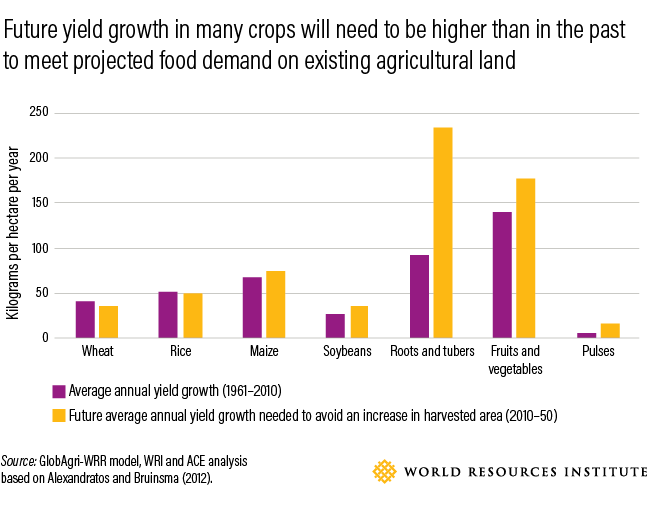The future of food - the fight for arable land
The world’s population is growing, while arable land is becoming an increasingly scarce resource. Today, one third of all global land is used for farming. To support the expected population growth by 2050, there is a land gap of nearly twice the size of India. It’s a daunting gap, which we need to fill. At the same time, a quarter of all GHG emissions comes from the food system, that’s 14 billion tonnes CO2e, out of which 80% comes from land use and agricultural production.
How can we ensure that we feed our growing population and reduce GHG emissions at the same time? Through innovation in the food system.
In this piece, we’ll take a look at two very different but both essential approaches to fundamentally altering how we produce, source, and deliver our food. We do this by leveraging synthetic biology and enhanced crops while also enabling farmers to become stewards of the land.
Looking decades ahead, we believe that Synthetic biology holds the key to reinventing our food system. This is the decade of biology.
Livestock uses most of the world's arable land but produces only 18% of the world’s calories, and 37% of the world’s protein. By finding alternatives to animal protein, we cannot only reduce emissions from the animals themselves, but also save valuable land and water in the process.
Enter Synbio.
Synthetic biology (or synbio) is the design and engineering of biological systems to fabricate components that do not already exist in the natural world. The technology is gaining momentum producing core compounds (new proteins, lipids, yeast and vitamins) creating alternative versions of food and materials that already exist today, from milk and egg, to fuel, materials and even beauty products. It’s emerging as a powerful approach in the search for key solutions to important challenges across climate, sustainability and health.
One of synbio’s most promising approaches is precision fermentation. The technology itself has been around for several decades but it has only recently emerged as one of the frontrunners for additional sources of proteins using gene-edited microbes. Companies such as Better Dairy and Perfect Day are creating dairy without using animals while reducing water use by 99% and emitting 97% less GHGs. With the advancements in synbio we are moving closer to a cow-free future.
“Better Dairy creates animal free dairy products being identical in flavour, texture, and nutritional profile to conventional dairy. We are using recent technological advancements in precision fermentation and synthetic biology allowing an even healthier and saver production of dairy while significantly reducing emission of greenhouse gases, saving valuable land and water without compromising taste”
- Bernd Gerhartz, CSO at Better Dairy.
Synbio is an exciting area of innovation with vast potential. While costs have come down drastically, they’re still prohibitive which limits the commercial potential and therefore real-world impact. The sector has several challenges in the value chain. There is a 100x gap in pilot and manufacturing space to meet projected demand for alternative proteins alone. In addition, facilities often lack in data management, analytics and automation limiting the ability to improve efficiency and lower cost in the process, a requirement for bio-based products to be competitive.
Synonym and Invert are two examples of startups building the picks and shovels to enable bioprocessing. Synonym is building a financing and development platform for large scale biomanufacturing capacity, to standardise the infrastructure buildout and connect the right financing to projects. Invert is building best-in-class data science and analytics tools to facilitate visibility, optimisation and automation of bioprocesses all the way from lab to large scale production. The two share the mission to enable companies to go to market faster and at competitive cost.
We expect to see a wave of further innovation and investment in infrastructure and enablement tools to support the synbio potential, to feed our planet and reduce GHGs.
While we believe synbio is the future, it’s inevitable that traditional agriculture will continue to play an important part in the food system. But it needs to change with more efficient use of land and innovation in the value chain.
Current farming practices have depleted our soils, destroying important nutrients and biodiversity, turning our farmlands into net carbon emitters. Scientists estimate that we’ve lost a third of the world’s topsoil, the most nutritious part of the soil, in the last 40 years. Farming alone is currently responsible for 19% of all greenhouse gas emissions.
Regenerative agriculture turns soils into net carbon sinks instead of emitters. Today, 1/3 of the world's land is used for farming, a shift to regenerative ag has vast potential to reduce atmospheric carbon. The practice also enhances crop productivity and eliminates soil erosion bringing back depleted soils to life, with improved yields.
For a farmer, the shift is easier said than done. Farming is a low margin business, and will only see rising pressure from increased climate volatility. Farmers are in desperate need of economic incentive to change their practices. We are seeing players such as Agreena enable the shift by supporting the farmers in changing their practices and mint high quality, verifiable carbon credits sold to corporates via a marketplace.
Selling into farmers is notoriously difficult and was long believed to be impossible for startups, many failed trying. However, the green economic incentive created by carbon credits is creating a wedge into farms and opening up possibilities for digitalisation to further enhance yields, reduce waste and improve efficiency in everything from fertilisers, pesticides and risk mitigation. Companies such as Kula Bio is developing a drop-in replacement for synthetic fertilisers that help farmers improve crop yields and reduce the environmental impact and nitrogen runoff.
We see a wide range of opportunities opening up, from robotics for harvesting, pest monitoring and control, to weather and supply chain intelligence and parametric insurance. In the future, we could see a single farming operating system providing farmers with a holistic view of their farms and tools to manage risks.
Advancements in AI will allow us to discover more resilient crops for changing local climates, cheaper and faster than ever before.
Changing climate means that some of our crops are no longer well suited to their new local environments. For example, NASA predicts that climate change will decrease maize crop yields by 24% within the next 10 years. This does not only impact our ability to feed our growing population but also farmers ability to sustain a living on already thin margins.
In traditional techniques, genes are transferred between plant varieties using crossbreeding across generations which is a very slow process. This is being sped up with precise biotechnological tools like DNA recombination and CRISPR genome editing techniques. But attractive traits are usually not a single gene, but a combination, which makes it a lengthy and costly process.
AI is advancing crop discovery, allowing for cheaper and faster selection of genes with the most suitable traits. Crops can not only be optimised for taste, and nutritional value, but can be enhanced to resist certain pests and diseases, as well as withstand climate conditions such as drought. For traditional farmers, more resilient crops has the potential to significantly improve yields. Enhanced crops can also reduce spoilage and stabilise production across years which gives farmers a more stable income stream.
Avalo is advancing natural crop evolution using AI to simulate the effects of changes to a plant’s genome and selecting the most attractive gene combination. The platform does not only significantly reduce the time to produce new crops but also reduce cost by an order of magnitude.
“On the discovery side, AI can help identify useful genes based on the correlations present in genomic data and in the inferred evolutionary history of a population (disclaimer: this is the process that Avalo focuses on of course!). However, AI can also be useful when trying to translate information from model plants, like Arabidopsis, Brachypodium, and even rice, into new systems. As the average discovery phase can last 2 years and cost $20m, it’s very helpful to speed this up.
On the development side, plant breeders have to try to predict which crossed plants are going to perform well before they put them in the field, meaning they have to sift through thousands of potential outcomes before they can identify the useful ones. AI lets them quickly sort through that data and focus on individual crosses that are more likely to advance progress in the right direction. In turn, this means that there are fewer generations of development, which translates into months or years of time.
Finally, on the trial side, it’s very difficult to translate success in the greenhouse to success in the field. Part of that discrepancy comes from the radically different environments and growing conditions. If AI can help plant biologists predict performance in different environments ahead of time, they’ll have a much better idea of which discoveries will maintain usefulness once they’re exposed to climatic and seasonal variability. This is where the bulk of development cost + time happens, so increasing efficiency here is where you can really reduce the crop development time by years.”
- Mariano Alvarez, co-founder of Avalo
Avalo opens up the possibility to optimise crops on a local level, de-risk concentrated supply chains and improve smaller crops in outlier markets. This could become essential to feed local communities, for example in certain parts of Africa.
What about indoor farming?
Vertical farming presents a more efficient use of land as crops are grown in vertical stacks. However, while efficiency is increasing and the cost curve is coming down, as we stand today, potential crops are constrained to leafy-greens, berries, cannabis and similar high value products to make the model work. It will take long before this technology moves the needle in terms of feeding the population.
At Giant, we remain optimistic about innovation in the food system, especially the opportunity in synbio which does not only have the potential to replace meat and dairy, but many petrochemicals we use in our daily lives today.
Are you a founder working in the space? Get in touch at madelene@giant.vc.
To read more on where we invest, take a look at our Manifesto. Or check out the team at Giant, our current portfolio giants, or read more of our insights.




